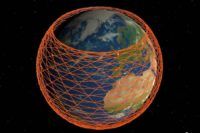With the delivery of 60 desk-size satellites into a low and cosy orbit, SpaceX completed the first phase of a remarkable project: to blanket the world with fast, affordable and reliable internet access. These 60 vessels, launched in late May, were the first components of Starlink Network; Elon Musk’s ambitious plan to offer worldwide broadband from space.
The Starlink Network and other similar initiatives could change the face of global connectivity, and digitally enfranchise billions of previously unconnected people.
Half the world’s population can’t access to the internet. The main obstacle to connecting them is a lack of infrastructure, which is expensive to build and maintain. Satellite broadband offers a smart, cost-effective solution to this problem. By establishing a direct, wireless connection between device and satellite, satellite-based internet removes the need for wires, pylons, and other equipment near the user.
Complete, ever-present connectivity beamed down from space. Billions of digitally-impoverished people granted sudden and reliable access to the internet’s great treasure trove of data, free expertise and puppy videos? It sounds magnificent, doesn’t it?
But we know what you’re really thinking: what does satellite broadband mean for me?
First, how will it work?
The concept is simple. An antenna on earth transmits information to a geostationary satellite. The satellite receives the data, alongside instructions of where to send it. The satellite relays the data to the specified location, where it’s received by a piece of equipment – a dish, usually – and translated by a ‘terminal’ into information that a consumer-facing device can interpret.
The relaying of data via satellite is not new or, in a sense, difficult. Just think about how long we’ve had access to satellite TV. Satellite broadband already exists, too. It’s just too slow and expensive in its current form to be used in anything other than special cases, like by journalists stationed in war zones, or on transoceanic flights where passengers are charged, for six hours of spotty connectivity, what they might ordinarily pay for a whole month’s worth of mobile data.
The tricky part – and the challenge SpaceX and its competitors are trying to overcome – is to create a satellite relay system with enough bandwidth to deliver broadband speeds to billions of active users. Solving this problem requires more sophisticated equipment, which is why later versions of Starlink’s satellites will include laser-based inter-vehicle communication, which will allow data streams to be sent directly between satellites, rather than via a relay station on the ground.

The other thing that’s needed is a whole lot more satellites capable of handling the throughput. This is why Starlink’s ‘mega-constellation’ will eventually comprise an astonishing 12,000 space vehicles. Launching and maintaining a network of 12,000 satellites is incredibly ambitious – for context, there are only 1,100 active satellites in orbit right now. It’s also hugely expensive. SpaceX estimates the total cost of Starlink to be around $10 billion, much of which will be eaten up by rocket fuel for its Falcon 9s.
Does This Mean Faster Internet?
The most significant impact will be felt by people without internet access, most of whom live in the developing world. The benefits of an internet connection to those communities are too large, numerous and complex to estimate. It’s safe to say, though, that reliable satellite broadband could be a massive humanitarian achievement, made real by ambition, skill and technology.
But what about people who already have connections? The short answer is, ‘it depends’. Starlink is due to come online in 2027, so we’ve got a little while to wait. When it does, it probably won’t make much difference to the inhabitants of modern, first-world metropolises. Their existing connections, provided by well-maintained, fixed-line fibreoptic cables, will be faster than those offered by the likes of Starlink.
Satellite broadband is hugely promising, but it suffers from one, unassailable drawback: satellites are far away. Their distance from earth, roughly 273 miles, adds latency. How much latency depends on the locations of various components in the connection. But it could be enough to make ground-based internet preferable, particularly for speed-dependent services and experiences like finance and gaming.
Some places in the UK may benefit, though. People living in rural villages or remote areas within otherwise well-connected countries might find satellite connections faster and more reliable than cabled connections, particularly if their signals are presently being carried by old-school copper wiring, not fibre optics. They’ll still have to wait a while for Starlink to come online, though. Hopefully, their terrestrial service will have improved by then.
Starlink’s Problems
Satellite-based broadband does pose two major problems. One is rubbish. Earth’s orbit is swamped with space-crap, like debris and old, decommissioned satellites, and there’s currently no way to clean it up. Increasing the population of orbital masses dramatically – as SpaceX plans to – could have equally dramatic consequences for the safety of equipment and astronauts in low orbit.
Change is afoot, though. The US government has introduced new ‘Space Debris Mitigation’ requirements, meaning manufacturers have to make specific plans for ‘decommissioning’ satellites once they reach end of life. These plans include ‘Design for Demise’ or D4D capabilities, where mechanisms will be installed in satellites to control where and when they break up in the atmosphere. Future iterations of Starlink satellites will have this capability, but the 60 satellites launched last month will have to burn up the old fashioned way.

Another problem posed by the likes of Starlink is light pollution. Watching a satellite amble peacefully across the horizon can be quite beautiful. But does watching hundreds of them, scurrying across the heretofore tranquil sky have quite the same appeal? Just look at this video of a coordinated Starlink’s first batch of satellites, forming a kind of supernatural train, and form your own opinion.
The pure visual annoyance is by no means the end of the problem. Some astronomers are concerned that the radio-wave and visible-light emissions from these vast humanmade ‘constellations’ will interfere with and confuse ground-based telescopes, stifling the study of space. The International Astronomical Union explained: “We do not yet understand the impact of thousands of these visible satellites scattered across the night sky and despite their good intentions, these satellite constellations may threaten both [nocturnal wildlife and research].”
Why is Musk Doing This?
As always, Musk’s motivations are a little unclear. In a recent earnings call, SpaceX projected that the Starlink Network could create somewhere between $40 and $50 billion a year in revenue. It’s quite the return, though the idea that SpaceX should prioritise immediate profitability over providing internet access to unconnected communities sours the magnificence of the project.
But profit never has been Musk’s top priority. He is less of a CEO and more of a technological pioneer coalescing, at times, to shareholder priorities.
One of his skills is using profitable, self-funding ideas as proving grounds for even more ambitious projects. Tesla is a glamorous front for battery production. SpaceX itself is probably a long-term play to establish human colonies on the Moon and Mars, to make space tourism a reality, and to mine asteroids for their riches. Satellite-based internet is the most logical way of connecting these various enterprises.
Could Starlink be an excuse to perfect satellite broadband before his eventual push to Mars?





